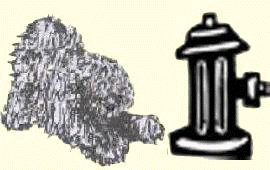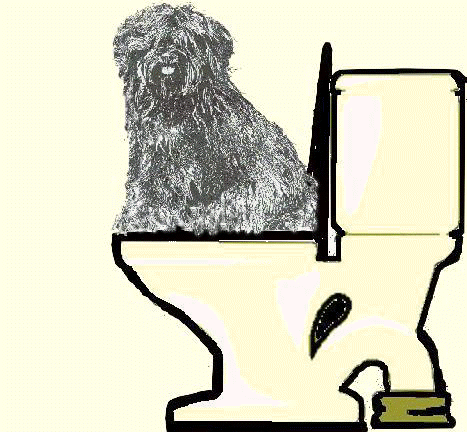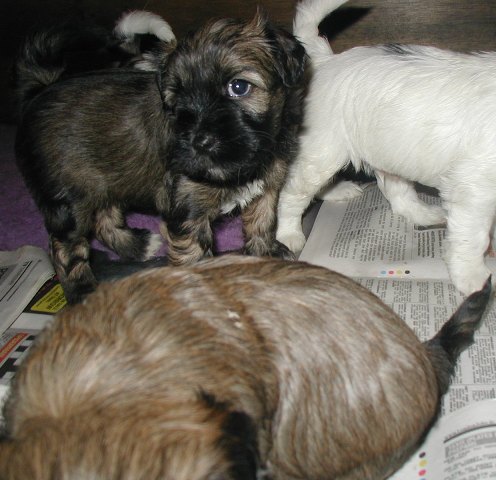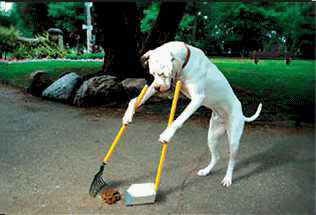|

HOUSEBREAKING
YOUR
PUPPY
One of
the first
priorities for
the new puppy
owner is
teaching the dog
where he should
and should not
do his business.
You can usually
housebreak a
puppy in a
few days
to a few weeks,
provided you
have the time to
give to the
task.
Housebreaking
Tips:
Take
your new puppy
home on a long
weekend or
holiday. This
way people can
be with him a
lot, easing the
loneliness he is
bound to feel
having left his
litter mates
behind. Lots of
attention also
makes the
housebreaking
easier and
quicker. An
important thing
to remember is
that puppies
generally do not
have complete
control until
they are about
six months old,
though they will
get better and
better at it!
Keep
your puppy
confined to a
safe, cleanable
area to avoid
the
disappointment
of ruined
carpets, except
for the time
just after he
has gone to the
loo (a tiled or
linoleum covered
floor is best).
Keep him in
sight, even
then, so he
doesn’t get into
mischief. He
does not know
the rules yet!
The kitchen is a
good place to
keep the puppy,
so he can be
included in the
family life
straight from
the start. Never
scold a new
puppy for having
an accident.
It’s your fault
for not watching
him! It takes
time to learn
the new rules.
After a few
weeks training,
you can let out
a firm “NO” if
you catch him in
the act inside
the house.
There
are two
excellent ways
of housebreaking
dogs, crate
training and
paper training.
If someone can
check in
frequently
during the day
after the first
few days, or
better still
stay at home for
about a week,
crate training
is the best
choice. If you
must be absent
all day, paper
training is the
best, because
puppies simply
cannot hold
their bladders
for more than
two to three
hours at a time.
Though if the
crate is big
enough, you
might have
bedding at one
end and paper at
the other.

Crate
Training:
I have heard
people say “We
don’t
cage, we care”.
A statement like
this is absolute
nonsense. The
animal is
perfectly happy
and above all
perfectly safe
when he is in
his crate. After
all it’s
his own space -
somewhere he can
go to escape the
rough and tumble
and just relax.
Dogs are den
animals, and
enjoy having a
cosy, safe place
to sleep and
rest. Dogs are
also clean
animals, and
they do not like
to soil their
beds. Use this
natural instinct
to help your
puppy develop
bladder and
bowel control
through crate
training. When
the puppy gets
used to his
crate, you can
keep him in it
for gradually
increasing
periods, up to
about two hours
at a time.
The crate should
not be too large
or he may soil
in the farthest
corner from his
sleeping spot.
If the crate is
big, put a small
cardboard box in
it. The crate
should be just
large enough for
puppy to turn
around and lie
down comfortable
in. Unless you
intend leaving
him for longer
periods of time
to keep him
safe.
Soon after
getting your
puppy home, get
him used to his
crate. Put a
nice treat or
something he
likes to play
with inside the
door and have
him go and fetch
it from inside.
Say something,
like
“In
your crate”
or
“Bed”
or “Kennel”.
Praise him and
give him a treat
for going in.
Repeat many
times, so that
going into the
crate is
associated with
something
pleasant. Then
try closing the
door, without
locking it, a
few times as you
continue to put
a treat or toy
inside first.
Soon you will be
able to lock the
door for just a
few seconds.
Then open it,
but don’t
make a big fuss
when he comes
out. Gradually
extend the time
until the dog is
comfortable
staying inside
for about two
hours. Then you
can put him in
his crate for a
few hours at a
time, when you
have to go out
or just don’t
want him
underfoot. If he
cries or
whimpers,
don’t
open the door
until he stays
quiet for a
minute or two.
Dogs are quick
learners. Don’t
teach him that
by crying he can
get his way!
Never
let him out
while he is
crying!
Your new puppy
needs lots of
rest. He can
take several
short naps each
day in his new
den. You can
leave something
comfortable like
a blanket or
towel, and a
favourite toy
inside to make
it feel like
home. When he
wakes up take
him outside
immediately.
When you cannot
watch the puppy,
he should be
confined either
to his crate or
a safe play
area. Don’t
lock him in his
crate too often
though. Try to
spend a lot of
time with your
Tibetan Terrier,
he will reward
you for it.
After waking,
after each meal,
or drink, and
several times
during the night
say something to
the puppy like,
“do
you have to go
outside?”
and take him out
to the spot
where you would
like him to go.
(Eventually,
when you say the
phrase, he will
show you by
running to the
door if he needs
to go.)
When outside,
wait until he
starts going to
the loo, then
while he’s
in the process,
say something
like
“Do
it!”
or
“Go
to the loo”
or
“Do
your business”
and give him
lots of praise.
It may take a
while, but after
some months he
will have an
irresistible
urge to go to
the loo whenever
you say the
command word.
This can be very
useful when you
are on a trip
with your dog
and you make a
pit stop on a
freezing night.
Be ever watchful
and take him out
often for the
first week, even
if you’re
just a little
suspicious. Wait
with him each
time you take
him outside
until you’re
certain
he’s
really empty
before you let
him back in the
house! This may
take a long time
for a new puppy,
but the fewer
accidents he has
indoors, the
quicker the
housebreaking
job will go.

Typical
Housebreaking
Schedule for the
First Weeks:
As long as the
puppy is being
watched, he can
stay out of his
crate. Do not
let him have the
run of the
house!
First thing:
Get up, take pup
outside.
Feed pup,
take him
outside.
Play with
pup, OK to let
him rest in
crate.
Mid-morning:
Release pup from
crate, take him
outside.
Play with
pup, OK to let
him rest in
crate.
Noon:
Release pup from
crate, take him
outside.
Feed pup,
take him
outside.
OK to let
him rest in
crate for a
little while.
Mid-afternoon:
Release pup from
crate, take him
outside.
Play with
pup, OK to let
him rest in
crate.
Tea-time:
Release pup from
crate, take him
outside.
Feed pup,
take him
outside.
Let pup
play in kitchen.
Mid-evening:
Take
pup outside,
play with him.
OK to let
him rest in his
crate for a
little while.
Bed-time:
Take pup outside.
Crate pup in
your bedroom or
the kitchen for
the night.
Initially you
will definitely
need to get up a
few times in the
middle of the
night to take
him out during
the first month.

Paper Training:
There are many
accepted ways to
paper train a
puppy. One
approach is to
cover the entire
floor in the
puppy’s
area with
newspaper. The
puddles and
messages may be
quite random at
first, but soon
the puppy will
choose one area
far from food
and bed to make
his “spot”.
Put several
dirty papers on
“the
spot” to give it
a strong scent
so the puppy
will be
attracted there.
Unlike the
star-ship
Enterprise
dogs prefer to
go where they
have gone
before!
As your
Tibetan
Terrier
begins to use
his
“spot”
more and more,
you can
gradually lessen
the
paper-covered
area until it is
fairly small.
Then move it
nearer the door
and eventually
outside.
Always remember
patience and
understanding
achieve much
more than
bullying or
shouting ever
could.


|